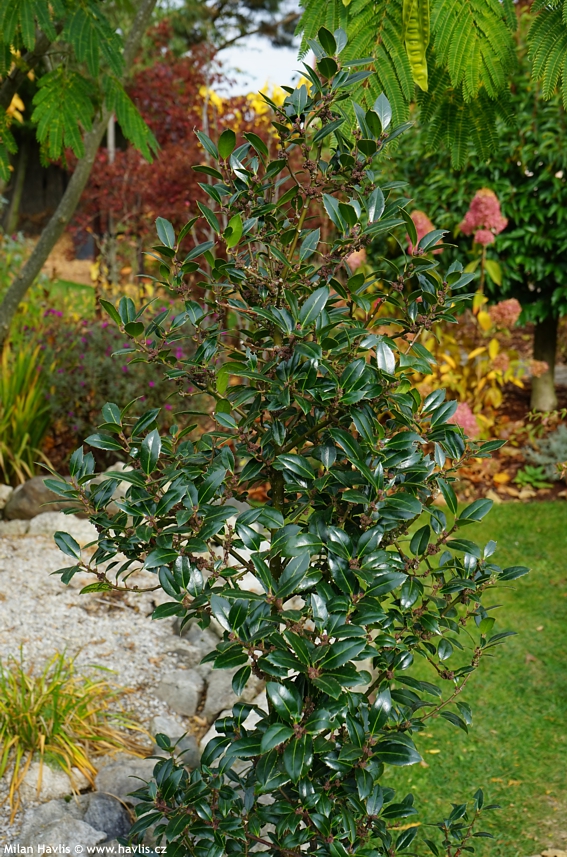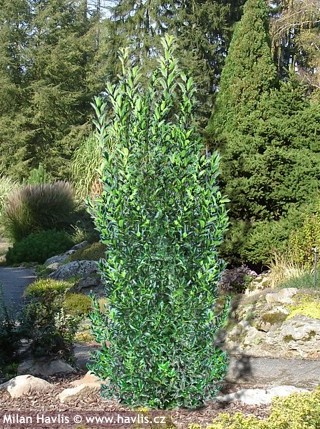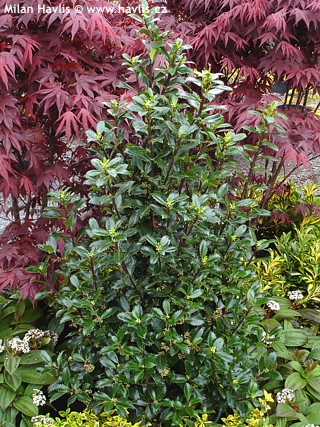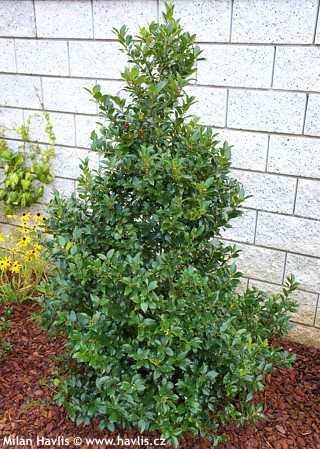Ilex aquifolium 'NIGRICANS' English holly - male
size/type
medium-sized shrub,taller shrub
usual height
3-5m
usual width
1-2m
leaves
evergreen broadleaf
colour of leaves
location
full to partial sun
soil type
acidic (peaty)
soil moisture requirements
evenly moist (dislikes drought)
USDA zone (lowest)
5b (down to -27°C)
winter protection
for zone 5+6

for zone 7

categorized
Description of the plant:
Nigricans is a rare variety of English holly which belongs to aquifolium group but produces foliage that is much closer to blue hollies (x meserveae hybrids). Its evergreen leaves are highly glossy, leathery, narrowly ovate to broadly elliptic, dark green with a conspicuous light green midrib and gently serrated margins. We cannot talk about spiny foliage here at all as the leaves are rather pleasant to touch. Some are borne almost entire, without any or just a few tiny spines. You can tell that it’s not a blue holly in winter because the leaves remain green unlike most blue hollies which turn dark purple blue from autumn till early spring.Nigricans is a male holly flowering profusely but not producing berries. However, plenty of pollen from its flowers pollinates many other female hollies around which then set fruit. They can be from any group – aquifolium, meserveae, altaclerensis etc. It grows moderately (20-25 cm per year) and strictly upright, forming a rather columnar habit of about 4m height. It can be pruned to be kept smaller. Spring pruning enhances branching, midsummer pruning is for shaping. And it is no problem to cut a few branches in winter for Christmas decorations.
Grow hollies in moist but well-drained, fertile soil. They can take periods of drought once established but dislike compacted, heavy-clay-based soils that turn very dry in summer, and often too wet in winter. If your soil is such, dig the planting hole only half the depth of the root ball, refine what you dig out and mix well with quality substrate of highly acidic level (low pH value). Using this mixture make a gradual slope from the stem to the original ground level and tamp it down as much as you can. Your root ball should not look like a molehill but more like a wide and flat mound. Mulch it well and keep watering it more often as it will be more prone to drying out as opposed to most common flat-in-the-ground transplanting.
Hollies do best in full sun but can also grow in shade where they will lose their compact habit. This variety proved very hardy even in full sun in winter. However, if you live in a region with cold winters and long-lasting frost we recommend growing it in position sheltered from drying winds, and preferably shaded from winter sun. Before and during winter when the soil is not frozen provide good watering. Hardy to about -27°C (USDA zone 5b).
Last update 02-12-2020
QUICK PRICE OVERVIEW
CURRENTLY SOLD OUT
WANT TO TRY A SIMILAR PLANT?


















